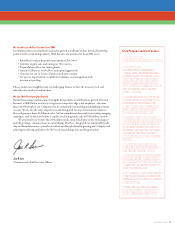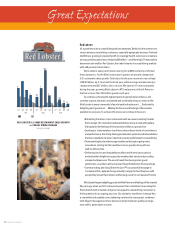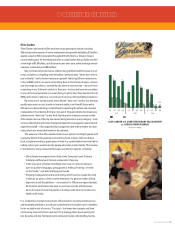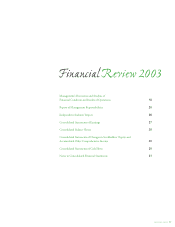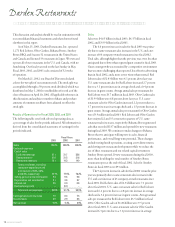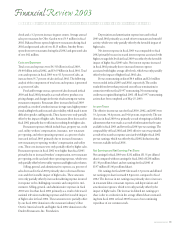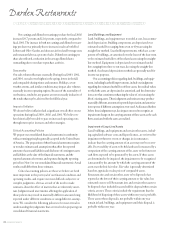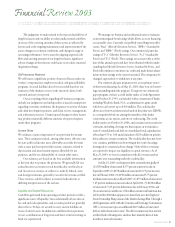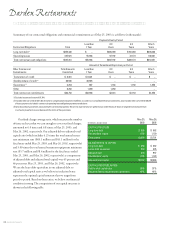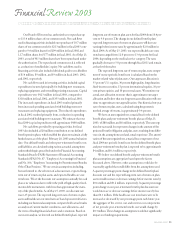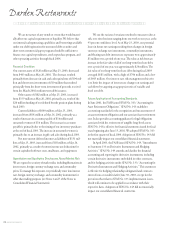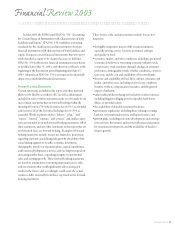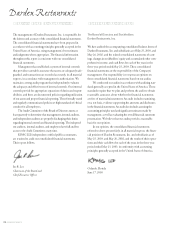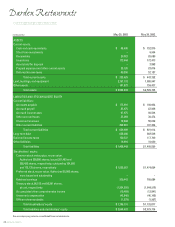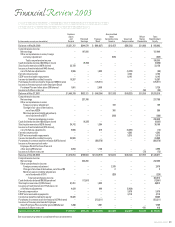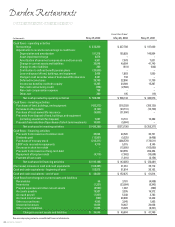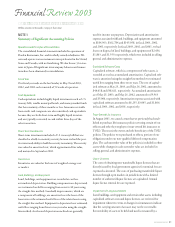Red Lobster 2003 Annual Report Download - page 23
Download and view the complete annual report
Please find page 23 of the 2003 Red Lobster annual report below. You can navigate through the pages in the report by either clicking on the pages listed below, or by using the keyword search tool below to find specific information within the annual report.
2003 ANNUAL REPORT 21
The judgments we make related to the expected useful lives of
long-lived assets and our ability to realize undiscounted cash flows
in excess of the carrying amounts of these assets are affected by
factors such as the ongoing maintenance and improvements of the
assets, changes in economic conditions, and changes in usage or
operating performance. As we assess the ongoing expected cash
flows and carrying amounts of our long-lived assets, significant
adverse changes in these factors could cause us to realize a material
impairment charge.
Self-Insurance Reserves
We self-insure a significant portion of expected losses under our
workers’ compensation, employee medical, and general liability
programs. Accrued liabilities have been recorded based on our
estimates of the ultimate costs to settle incurred claims, both
reported and not yet reported.
Our accounting policies regarding self-insurance programs
include our judgments and independent actuarial assumptions
regarding economic conditions, the frequency or severity of claims
and claim development patterns, and claim reserve, management,
and settlement practices. Unanticipated changes in these factors
may produce materially different amounts of reported expense
under these programs.
Income Taxes
We estimate certain components of our provision for income
taxes. These estimates include, among other items, effective rates
for state and local income taxes, allowable tax credits for items
such as taxes paid on reported tip income, estimates related to
depreciation and amortization expense allowable for tax
purposes, and the tax deductibility of certain other items.
Our estimates are based on the best available information
at the time that we prepare the provision. We generally file our
annual income tax returns several months after our fiscal year-
end. Income tax returns are subject to audit by federal, state,
and local governments, generally years after the returns are filed.
These returns could be subject to material adjustments or
differing interpretations of the tax laws.
Liquidity and Capital Resources
Cash flows generated from operating activities provide us with a
significant source of liquidity. Since substantially all our sales are
for cash and cash equivalents, and accounts payable are generally
due in five to 30 days, we are able to carry current liabilities in
excess of current assets. In addition to cash flows from operations,
we use a combination of long-term and short-term borrowings to
fund our capital needs.
We manage our business and our financial ratios to maintain
an investment grade bond rating, which allows access to financing
at reasonable costs. Currently, our publicly issued long-term debt
carries “Baa1” (Moody’s Investors Service), “BBB+” (Standard &
Poor’s) and “BBB+” (Fitch) ratings. Our commercial paper has
ratings of “P-2” (Moody’s Investors Service), “A-2” (Standard &
Poor’s) and “F-2” (Fitch). These ratings are accurate only as of the
date of this annual report and have been obtained with the under-
standing that Moody’s Investors Service, Standard & Poor’s, and
Fitch will continue to monitor our credit and make future adjust-
ments to these ratings to the extent warranted. The ratings may be
changed, superseded, or withdrawn at any time.
Our commercial paper program serves as our primary source
of short-term financing. As of May 25, 2003, there were no borrow-
ings outstanding under the program. To support our commercial
paper program, we have a credit facility under a Credit Agreement
dated October 29, 1999, as amended, with a consortium of banks,
including Wachovia Bank, N.A., as administrative agent, under
which we can borrow up to $300 million. The credit facility
allows us to borrow at interest rates based on the prime rate, LIBOR,
or a competitively bid rate among the members of the lender
consortium, at our option, and on our credit rating. The credit
facility expires on October 29, 2004, and contains various restrictive
covenants, including a leverage test that requires us to maintain a
ratio of consolidated total debt to consolidated total capitalization
of less than 0.55 to 1.00 and a limitation of $25 million on priority
debt, subject to certain exceptions. The credit facility does not, how-
ever, contain a prohibition on borrowing in the event of a ratings
downgrade or a material adverse change. None of these covenants
are expected to impact our liquidity or capital resources. As of
May 25, 2003, we were in compliance with all covenants and no
amounts were outstanding under the credit facility.
At May 25, 2003, our long-term debt consisted principally of:
(1) $150 million of unsecured 8.375 percent senior notes due in
September 2005, (2) $150 million of unsecured 6.375 percent notes
due in February 2006, (3) $150 million of unsecured 5.75 percent
medium-term notes due in March 2007, (4) $75 million of unsecured
7.45 percent medium-term notes due in April 2011, (5) $100 million
of unsecured 7.125 percent debentures due in February 2016, and
(6) an unsecured, variable rate, $34 million commercial bank loan due
in December 2018 that supports two loans from us to the Employee
Stock Ownership Plan portion of the Darden Savings Plan. Through a
shelf registration on file with the Securities and Exchange Commission
(SEC), we may issue up to an additional $125 million of unsecured
debt securities from time to time. The debt securities may bear interest
at either fixed or floating rates, and may have maturity dates of nine
months or more after issuance.
Financial Review 2003
ManagementÕs Discussion and Analysis of Financial Condition and Results of Operations


